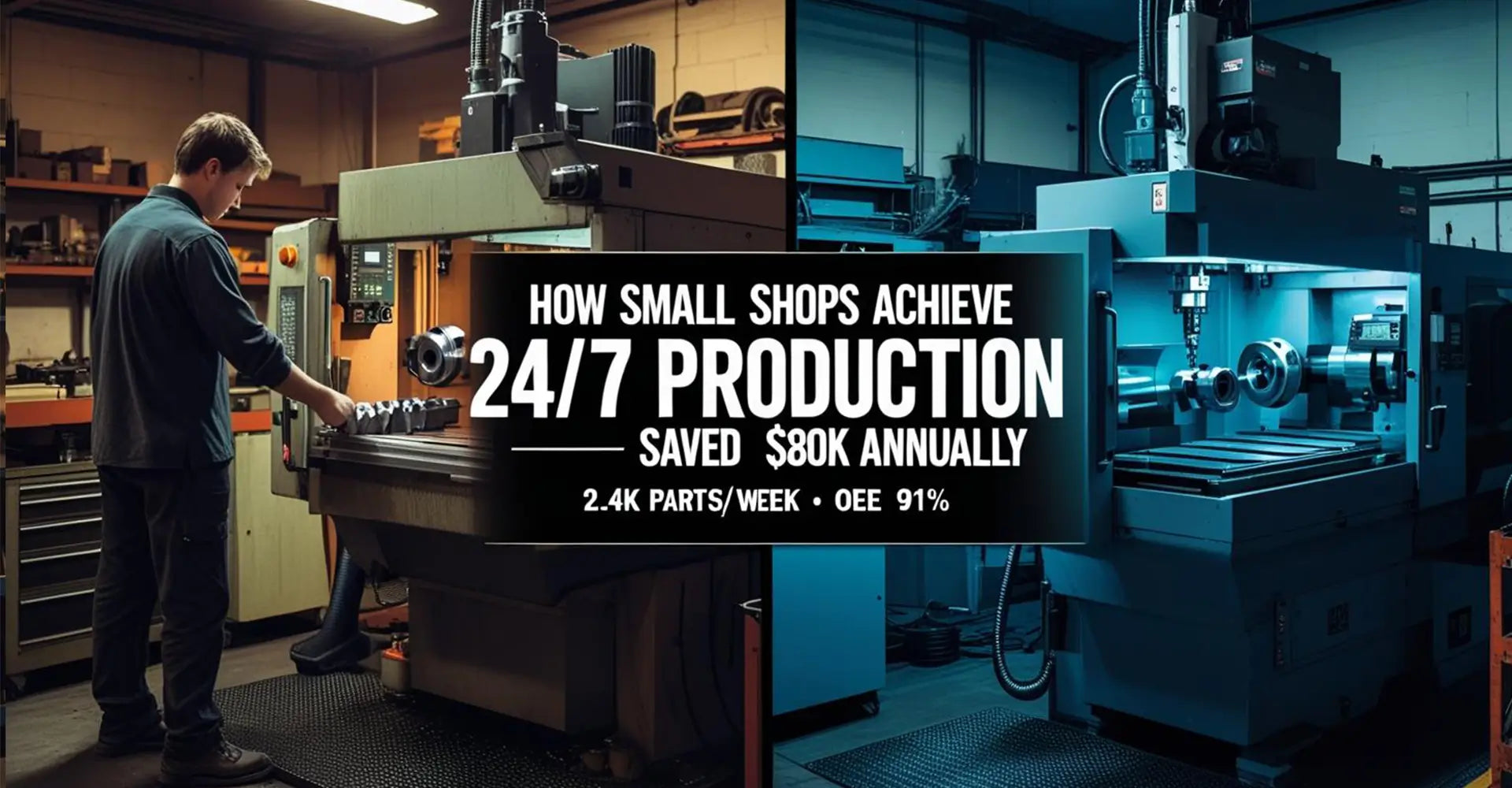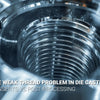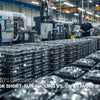How Small Shops Achieve 24/7 Production: The Complete Guide to CNC Auto-Feeding Systems That Saved Us $80k Annually?

How Small Shops Achieve 24/7 Production: The Complete Guide to CNC Auto-Feeding Systems That Saved Us $80k Annually?

Small machine shops face a critical challenge: maximizing production while controlling labor costs. The solution lies in CNC turning auto-feeding system technology that enables continuous operation without human intervention. This comprehensive guide reveals how we implemented automated feeding solutions in our 15-person shop and achieved remarkable results within the first year. Furthermore, the insights shared here will help you understand why automation is no longer exclusive to large manufacturers.
Key Results at a Glance:
- $80,000+ annual labor cost savings
- 40% improvement in OEE (Overall Equipment Effectiveness)
- 2,400 parts per week vs. previous 1,000
- ROI achieved in 14 months
- Zero night shift requirements
- Reduced scrap rate from 5% to 2%
Whether you're considering bowl feeders, robotic systems, or complete automated cells, this guide provides the real-world data and implementation strategies you need to make an informed decision. Additionally, we'll explore how different CNC turning applications benefit from various automation approaches and help you avoid costly mistakes during implementation.
Table of Contents
- Why Most Small Shops Hesitate (And Why They Shouldn't)?
- Which Auto-Feeding System Fits Your Production Needs?
- The Real Cost Breakdown: Investment vs. ROI Analysis?
- Step-by-Step Implementation Without Costly Mistakes?
Why Most Small Shops Hesitate (And Why They Shouldn't)?
Many small shop owners believe automation is only viable for high-volume production runs. However, this misconception prevents them from realizing significant cost savings and production improvements that are achievable even with batch sizes of 500-1,000 parts. Moreover, the landscape has changed dramatically, making automation accessible to shops that previously couldn't justify the investment.
Common Misconceptions vs. Reality:
- Myth: Need massive production volumes
- Reality: ROI comes from lights-out manufacturing, not batch size
- Myth: Too expensive for small operations
- Reality: Entry-level systems start at $18,000
- Myth: Complex integration requirements
- Reality: Most systems use standard I/O connections
- Myth: Only works for simple parts
- Reality: Advanced systems handle complex geometries
The breakthrough insight from industry forums and real-world implementation is that automation pays for itself through extended operating hours rather than speed increases. Consequently, a job requiring 8 hours of manual supervision can run unattended for 16+ hours overnight, effectively tripling daily output without overtime costs. This shift in thinking makes automation viable for shops previously considered "too small" for such investments. Additionally, reduce labor CNC strategies focus on eliminating the need for constant operator presence rather than replacing workers entirely. Many successful implementations involve retraining operators to manage multiple automated systems, thereby increasing their value and job security while improving shop profitability.
Which Auto-Feeding System Fits Your Production Needs?
Selecting the right feeding system depends on your part geometry, production volume, and changeover requirements. Three primary options dominate the market, each with distinct advantages and cost structures. Therefore, understanding these differences is crucial for making the right investment decision for your specific CNC machining service requirements.
System Selection Matrix:
| System Type | Best For | Cost Range | Changeover Time |
|---|---|---|---|
| Vibratory Bowl Feeder CNC | Small, symmetrical parts (pins, bushings) | $18k-$28k | 15-30 minutes |
| Gantry Loader System | Larger, complex geometries | $40k-$65k | 5-15 minutes |
| Automatic Bar Feeder Integration | High-volume bar stock production | $25k-$50k | 30-60 minutes |

The decision matrix extends beyond initial cost considerations. Vibratory bowl feeder CNC systems excel with pins, bushings, and similar symmetric parts but struggle with complex geometries or delicate surfaces. Meanwhile, gantry loader system technology offers maximum flexibility for part changeovers and handles irregular shapes with ease, making them ideal for rapid prototyping applications where part variety is high. On the other hand, bar feeders provide the lowest per-part cost for high-volume runs but offer limited part variety. Consider changeover frequency, part complexity, and production volume when making your selection. Furthermore, newer systems integrate seamlessly with existing robotic loading CNC lathe setups, allowing for phased implementation that spreads costs over time.
The Real Cost Breakdown: Investment vs. ROI Analysis?
Understanding the true ROI automation machining potential requires analyzing both obvious and hidden costs. Our detailed financial analysis reveals how a mid-range investment delivers measurable returns within 14 months. Subsequently, the data shows that most shops underestimate both the costs and benefits of automation implementation.
Annual Savings Breakdown:
| Cost Factor | Manual Operation | With Auto-Feeder | Annual Savings |
|---|---|---|---|
| Labor (Night Shift) | $65,000 | $0 | $65,000 |
| Scrap Rate | 5% ($12,500) | 2% ($5,000) | $7,500 |
| Increased Capacity | 1,000 parts/week | 2,400 parts/week | $12,500 |
| System Investment | - | ($45,000) | - |
| Total First-Year ROI | - | - | 89% |
The calculation includes factors often overlooked in initial assessments: reduced handling damage, consistent cycle times, and improved OEE improvement turning through elimination of shift-change downtime. Our OEE improvement from 65% to 91% resulted from three key factors: availability increased (no breaks, lunch, shift changes), performance improved (consistent 45-second load times vs. 60-90 seconds manual), and quality enhanced through reduced handling variations. These compound effects create ROI scenarios that often exceed initial projections. Moreover, the ability to create an unmanned machining cell opens opportunities for taking on larger contracts that previously required additional staffing. Many shops find that automation enables them to bid more competitively on projects while maintaining healthy margins.
Step-by-Step Implementation Without Costly Mistakes?
Successful automation integration requires careful planning, proper safety interlocks, and systematic testing. Learning from common pitfalls prevents costly delays and ensures smooth startup. Additionally, working with experienced industrial machinery specialists can significantly reduce implementation risks and accelerate time-to-production.
Implementation Checklist:
- ✅ Digital I/O module installation and programming
- ✅ PLC integration for machine-robot communication
- ✅ Safety interlock system design and testing
- ✅ Custom workholding and part orientation verification
- ✅ Operator training and maintenance procedures
- ✅ Production testing with various part geometries
- ✅ Documentation and troubleshooting guides
The most common failure point involves part jamming and misorientation in feeding systems. Therefore, investing in custom-designed vibratory bowl tooling tracks specific to your part geometry eliminates 90% of feeding issues. Additionally, retrofit integration with older CNC controls is more straightforward than expected - most systems use standard 24V I/O signals for "part complete," "cycle start," and "fault" communications. Professional integrators specializing in small shop retrofits can typically complete installation within 2-3 days with minimal production interruption. Furthermore, proper planning ensures that your automation system grows with your business needs, allowing for future expansion without major system overhauls.
Conclusion
CNC auto-feeding systems represent a proven path to continuous production for small shops willing to challenge traditional assumptions about automation viability. The key lies in understanding that ROI comes from extended operating hours rather than increased cycle speeds. With proper system selection, realistic cost analysis, and careful implementation, shops can achieve significant labor savings while improving overall equipment effectiveness.
Start with a thorough analysis of your current production patterns, identify which parts run longest, and calculate the potential savings from unattended operation. The path to 24/7 production begins with understanding your specific requirements and selecting the appropriate feeding technology. Remember, automation success depends on choosing the right system for your specific needs rather than the most advanced available option.
[External Links Recommendation]
[CNC turning auto-feeding system][^1]
[automatic bar feeder integration][^2]
[robotic loading CNC lathe][^3]
[gantry loader system][^5]
[OEE improvement turning][^6]
---
[^1]: Understanding CNC turning auto-feeding systems can enhance your machining efficiency and productivity.
[^2]: Exploring automatic bar feeder integration can reveal ways to streamline operations and reduce labor costs.
[^3]: Explore this link to understand how robotic loading enhances efficiency and precision in CNC lathe operations.
[^4]: Discover insights on how unmanned machining cells can revolutionize production processes and reduce labor costs.
[^5]: Understanding gantry loader systems can enhance your knowledge of automation in manufacturing, improving efficiency.
[^6]: Exploring OEE improvement strategies in turning can help optimize production and reduce waste in manufacturing.





